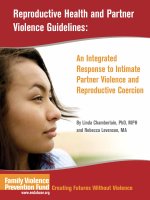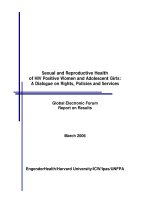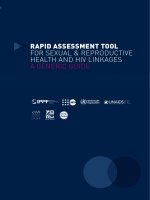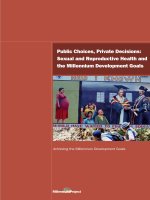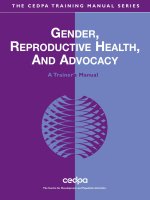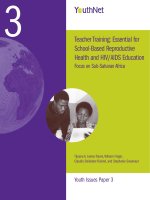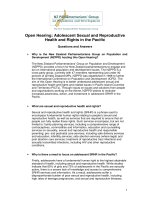Rapid assessment tool for Sexual & reproductive HealtH and Hiv linkages: a generic guide pot
Bạn đang xem bản rút gọn của tài liệu. Xem và tải ngay bản đầy đủ của tài liệu tại đây (797.22 KB, 88 trang )
The key contributors were:
Reviewers included:
Table of Contents
Acknowledgements 3
Acronyms 5
Working Denitions of Selected Terms 6
Introduction 8
Benets 8
Principles 9
Purpose of the Tool 10
Background 10
Specic Instruments 13
I. Policy 14
II. Systems 26
III. Clinical Service Delivery 38
a. Provider Interview 41
b. Client Exit Interview 66
Appendices
1. Sample Consent Form 76
2. Conducting a Desk Review 77
3. Budget Outline for Estimating Cost of 79
Conducting a Two-Month Rapid Assessment
4. Health Workers’ Capacity to Perform SRH and 82
HIV Functions
5. List of Selected Possible Next Steps for Utilizing 83
the Assessment Findings
Acronyms
AIDS
ANC
ART
BCC
CSO
FBO
FP
GNP+
HBC
HIV
IDU
IEC
ICW
IPPF
M&E
MNH
MOH
MSM
MTCT
NGO
OI
OVC
PEP
PHC
PITC
PLHIV
PMTCT
RTI
SRH
STI
SW
UN
UNAIDS
UNFPA
VCT
WHO
The following working denitions
are proposed in order to facilitate
consistent understanding
and interpretation of the
terms used in this Guide.
Working Denitions of Selected Terms
1.
2.
3.
4.
5.
6.
7.
8.
9.
10.
11.
Introduction
Benets
Rapid Assessment Tool for Sexual & Reproductive
Health and HIV Linkages: A Generic Guide
Principles
Address structural determinants:
Focus on human rights and gender:
Promote a coordinated and
coherent response:
Meaningfully involve PLHIV:
Foster community participation:
Reduce stigma and discrimination:
Recognise the centrality of sexuality:
12.
13.
14.
Purpose of the Tool
Background
Who developed this tool?
Who can use the ndings?
How is this tool structured?
How should this tool be used?
Rapid Assessment Tool for Sexual & Reproductive
Health and HIV & AIDS Linkages: A Generic Guide
Who should participate in group
discussions or be interviewed?
A Policy decision-makers and
programme planners
1
2
3
4
5
6
7
B Civil society and community leaders
1
2
3
4
5
6
15.
C Donors and development partners
1
2
3
D Service providers in the following
settings where SRH and/or
HIV services are available
1
2
3
4
5
6
E Clients of the following services
1
2
3
4
5
6
7
8
9
How should the assessment
be conducted?
1 Establish an assessment team:
2 Select a coordinator:
3 Conduct a desk review:
4 Outline the process of the
linkages assessment:
Rapid Assessment Tool for Sexual & Reproductive
Health and HIV & AIDS Linkages: A Generic Guide
5 Host group discussions with policy
and programme stakeholders
and programme managers:
6 Train interviewers and supervise
eld interviews:
7 Analyse data and compile
report and presentation:
8 Review ndings and decide on
next steps:
Specic Instruments
General introduction
:
Suggested methodology for answering questions
First conduct a desk review (See Appendix 2)
making notes on some of the questions with
factual information available in reports and other
documentation. The desk review should serve as
background material for the nal report. Then
consider informally conducting a few key informant
interviews which can help in setting the scene and
preparing for the group discussion. Next hold a 2 or 3
day retreat with key policy-makers and stakeholders
to develop and record consensus answers.
Preliminary Questionnaire Information
Are there any bi-directional linkages
between SRH and HIV in the country?
(If yes), Which linkages exist?
Is there a national HIV strategy/policy?
16
(If yes) Does it include SRH issues?
(If yes) Have these been made into priorities?
(If yes) To what extent do HIV policies
address the rights and SRH needs of PLHIV?
A. Political Positions
National Policies/Guidelines
16.
Is there a national SRH strategy/policy?
(If yes) Does it include HIV prevention,
treatment, care and support issues?
(If yes) Have these been made into priorities?
How do the respective HIV and SRH
strategies/policies address the following four
illustrative structural vulnerability factors:
Gender inequalities?
Low level of engagement of
men in responses?
HIV-related stigma and discrimination?
Social, legislative, policy and community
attitudes towards key populations (e.g.
MSM, SWs, IDUs, sexual minorities,
migrants, refugees, displaced
populations, young people)?
List the service protocols, policy guidelines,
manuals, etc, that are specically geared
towards increasing SRH and HIV linkages.
Are these protocols, policy guidelines,
manuals, etc, being used?
This part of the questionnaire aims
to determine the extent to which the
legislative framework supports (or
does not support) the implementation
of SRH and HIV linkages. (This list not
exhaustive; it is given as initial guidance.)
Are there laws against gender-
based violence?
(If yes) How effectively are
these laws enforced?
(If yes) Is the public well informed
about the existence of these laws?
(If yes) Has there been an observable
change (decrease/increase) in reporting
of cases of gender-based violence since
the implementation of the law?
What is the legal age for (and is it
the same for men and women):
Marriage?
HIV testing (independent of consent/
approval from a parent or caretaker)?
Accessing SRH services? Does it
depend on marital status?
Consent for sexual intercourse
and how does this compare to the
usual age of sexual debut?
To what extent are the above legal
ages respected and/or monitored?
What are the laws affecting key groups
(a. SWs, b. IDUs, c. MSM , d. other) and what
is their impact?
Are there anti-discrimination
laws protecting PLHIV?
(If yes) Has there been legal action by
PLHIV against employees/colleagues/
communities/services based on
discrimination on HIV status?
(If yes) What was the outcome
of this legal action?
(If yes) Are the law enforcement
and judiciary agents trained in the
implementation of these laws?
Have there been any cases or are there
policies or legislation to criminalise HIV
transmission and, if so, what is their impact?
Within the broader SRH operational
plan, are there any explicit activities to
improve access, coverage and quality
of care, including for HIV, for:
General population?
Key populations (e.g. MSM,
SWs, IDUs, young people)?
PLHIV?
Men?
Women?
Within the broader HIV operational
plans are there any explicit activities
to improve access, coverage and
quality of SRH services to:
General population?
Key populations (e.g. MSM,
SWs, IDUs, young people)?
PLHIV?
Men?
Women?
What are perceived to be the common
elements of a rights-based approach
within SRH and HIV-related services?
What are the differences?
What can be potential contentious/
conicting topics?
Has a workplace policy been developed
and adopted by the government?
(If yes) Has it been adapted to include SRH
components, HIV components or both?
(If yes) Is there a monitoring tool for its
implementation at all levels across the
country and how widely is it used?
What specic SRH and HIV policies support
condom (male and female) access?
(If there are some policies) Are these
policies stand-alone or are they delivered
within other programmes/policies?
(If there are some policies) Are these
policies aimed at protection against
unintended pregnancies? Against
STIs, including HIV? Or both?
What specic policies are there on
condentiality and disclosure for HIV-
related services whether administered
through SRH or HIV-related programmes?
B. Funding/Budgetary Support
What specic SRH and HIV policies support
condom (male and female) access?
What are the main sources of funding for:
SRH?
HIV?
Linkages?
Possible prompts:
Do donors support SRH and HIV- related
work within the same programmes? or
focus on each of the two separately?
Are there specic donor-driven actions to
integrate and/or improve the linkages of
the two?
Are there specic cases of donors putting
restrictions on HIV programmes regarding
SRH components or vice versa, are there
any specic cases of donors putting
restrictions on SRH programmes
regarding HIV?
What specic SRH and HIV policies support
condom (male and female) access?
Within the HIV budget, what is the
proportion allocated to core SRH
services within HIV-related services?
Within the budgets for specic SRH
services, what is the proportion allocated
to HIV prevention and care within SRH?

